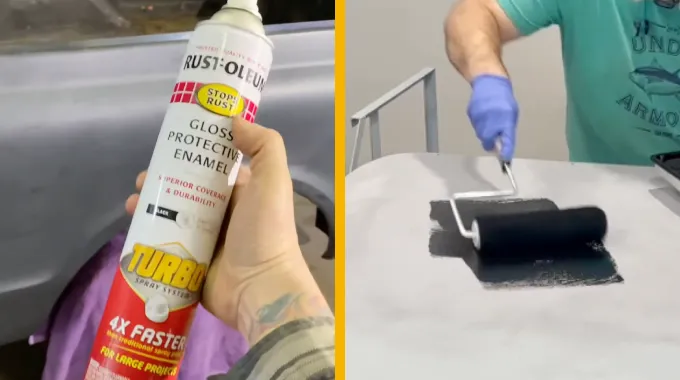Last Updated on March 16, 2023
When painting a trailer, you have two general options: spray paint in a can and roll paint. These techniques can provide different advantages depending on the project’s needs.
A spray paint job, however, is usually faster and easier than applying paint with a roller. Rolling the paint can also result in thicker layers for greater durability and chip resistance.
Our blog about spray paint versus roll will explore durability, drying time, coverage, rust prevention, painting wheels, plastic trucks, back-rolling technique, finish texture, and cost. So, let’s get started with the basics of trailer painting.
Spray Paint in A Can Vs Roll for Trailer: 9 Differences
Painting a trailer can be tricky to get just right. But with two main options, spray painting or rolling; you’ll surely find one that suits your needs best. Let’s dive into the pros and cons of each method so you can make an informed decision on which will craft the perfect finish for your trailer.
1. Durability for Chipping Resistance:
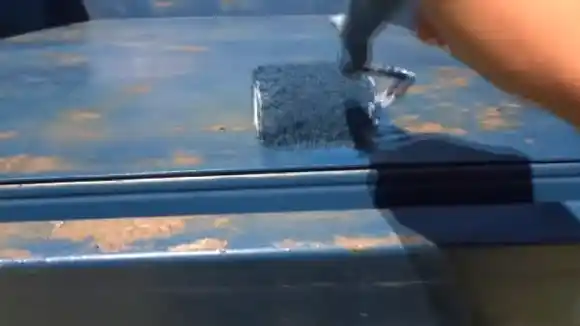
When considering the level of durability in terms of chipping resistance, spray paint in a can and rolling paint have distinct differences. Spray paint in a can is best suited for smaller areas due to its quick application and drying time.
It also provides unique textures and designs not available with rolling paint. However, it is difficult to control in windy conditions, often resulting in overspray and wasted paint or messes. Additionally, the thickness of the paint layer may be uneven, leading to chipping.
Conversely, rolling paint is a traditional approach that results in a thicker layer of paint prone to chipping or flaking off over time. It can better resist windy conditions and reduce overspray while providing cost-effective coverage over larger areas.
Rolling requires more preparation before application, such as priming and sanding, but avoids leaving any unwanted texture from the final finish job. Both types of painting provide durable chipping resistance however, one may be better suited depending on the trailer application.
2. Finish
Roll paint and spray paint differ primarily when painting a trailer is the finish they provide. Spray paint provides an even, smooth finish but requires extensive preparation before application. Also, multiple coats and extended drying times between each one are often necessary.
On the contrary, roll paint produces a textured finish that is less likely to chip over time and effectively hides imperfections in the surface below it. While it is faster and easier to apply than spray paint, drips and swipes can be left on the trim if not done correctly.
3. Drying time
Spray paint can have an obvious advantage over roll paint regarding drying time. The spray paint is atomized into tiny droplets, providing an increased surface area that allows the paint to dry faster.
On the other hand, roll paint requires more time to dry due to its thicker layers which take longer to evaporate. In the case of painting trailers, drying time can be crucial, so using spray paint in a can instead of rolling paint could save a lot of time and hassle.
4. Coverage
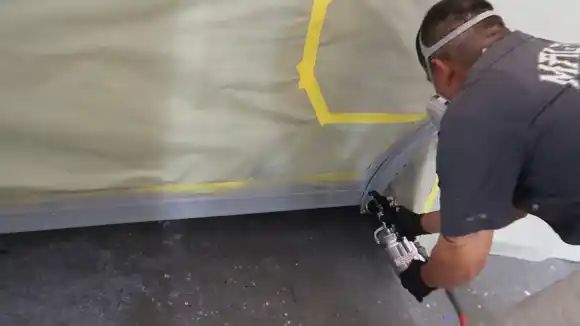
Regarding coverage, spray paint in a can is advantageous over roll paint. Due to their atomized particles, spray paints require less coverage than roll paints, which need more products for the same effect.
In addition, multiple coats may be needed for spray paints, whereas roll paints may only require fewer coats. Therefore when painting trailers, using spray paints rather than rolls of paint could be helpful as it would allow you to achieve the desired result with fewer products and coats.
5. Rust Prevention
Spraying paint in a can is convenient and easy to keep smaller trailers from rusting. It is best for tight areas that are difficult to reach and can be applied in thin, even coats for effective rust prevention.
Roll paint may be more efficient for larger trailers if the job requires a thicker coat, as it will provide better protection against rusting. The best choice depends on the size of the trailer and personal preference; however, proper surface preparation is essential no matter what paint is used to ensure effective adhesion and protection from rust.
6. Texture:
Spray paint in a can and rollers are two different methods of applying paint to a trailer that creates very different textures. Spray paint creates a smooth, uniform finish with minimal texture, while rolling will leave behind more texture.
When using spray paint, the layer of paint applied is usually thinner than when using a roller, resulting in less chipping on surfaces. The downside to spray painting is that it requires more preparation time, and the risk of overspray remains high if done incorrectly.
Alternatively, when rolling, the user has more control over the texture achieved, and it is possible to reach difficult areas accurately. However, this method takes longer and requires more skill to get an even finish, making it more time-consuming than spraying.
When deciding between spray painting and rolling for trailer application, consider your desired outcome, whether you prefer a smoother surface or one with greater texture, and how much time you have available for the job.
7. Painting Trailer Wheels and Plastic Trailers
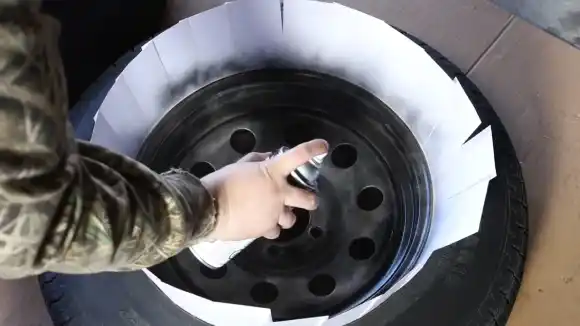
Cans of spray paint are ideal for small projects such as painting wheels or plastic parts on a trailer since it provides easy access to hard-to-reach areas. Although it takes longer to apply, roll paint is suitable for larger projects requiring thicker coats of paint, providing extra protection against corrosion damage.
However, spray painting may be the better option for any small-scale project due to its difficulty in tight spaces.
8. Back Rolling
Back rolling is a technique used in painting that involves applying pressure to the paint roller with a second roller or brush. This helps to even out imperfections in the paint finish and helps it adhere better to the underlying surface.
Back rolling is essential for ensuring even and reliable coverage when spray painting a trailer. The spray-on paint can often leave behind small droplets or streaks due to air pressure and will not have the same degree of coverage as roll painting. You should always follow up with backrolling techniques to get the best roll painting results.
This helps spread out any uneven spots and ensures that your paint job lasts longer since it will be better protected against weathering and other environmental factors.
9. Cost
Regarding trailer painting, the main difference between cans and rolls is the cost. Spray paint is often more expensive than roll paint, especially when covering larger areas. However, it is convenient for small areas or touch-ups and provides a smoother finish with less prep work required.
In contrast, roll paint is cost-effective for larger areas because it allows for a thicker coat that hides imperfections better than spray paint. Although roll painting may be messier and require more time and effort to apply, the result will be worth it due to its affordability and durability.
Is It Better to Roll Paint or Spray on a Trailer?
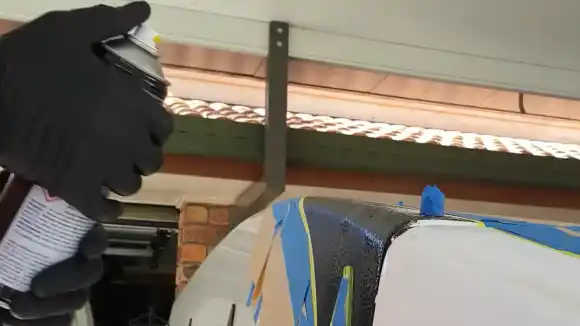
When it comes to painting a trailer, both rolling paint and spray paint have their advantages. Rolling paint is often better for larger surfaces as it provides more resistance to rust, requires fewer coats, and has a longer textured finish.
Furthermore, spray paint is ideal for smaller tasks like painting wheels and can provide an even and smooth surface without requiring much prep work. It also requires less product for coverage and can be used to prevent rust on smaller trailers.
Ultimately, the decision of which method to use will depend upon the extent of the project and any additional requirements.
Should You Paint Trailer Wheels With A Roller?
Rollers can be used to paint trailer wheels, but the shape and design of trailer wheels make it hard to get a smooth finish. It also takes considerable effort. Spray paint is better for painting trailer wheels since it covers uneven surfaces more efficiently and gives a professional look.
It also dries faster, sticks better, and comes in many colors to find the perfect one for your trailer. Make sure to clean, degrease, sand, and prime the surfaces before painting for the best results.
Is It Worth Getting a Spray Paint for a Trailer?
If you choose a rust-resistant, long-lasting, high-quality spray paint that meets your trailer’s specific requirements, it is worthwhile to paint it. Trailers can be exposed to harsh weather conditions, and therefore, good quality paint is essential to protect from UV rays, moisture, and corrosion.
In addition, spray paints are a time-saving and efficient option when painting large surfaces. However, if you prefer applying paint with a brush, consider using high-quality brush-on paint that offers long-lasting protection and an appealing finish.
Can You Paint Over the Rusted Metal on the Trailer?
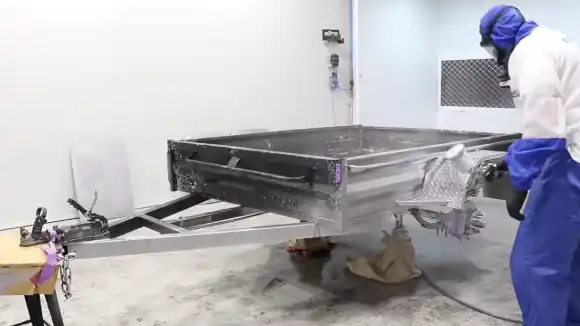
Properly prepare the trailer surface before painting over rusted metal to achieve long-lasting results. Start by removing any loose rust and peeling paint using a wire brush or sandpaper, ensuring you reach all the affected areas.
After thoroughly cleaning the metal, let it air-dry completely to avoid trapping moisture beneath the new paint layer. Applying a rust inhibitor may also be beneficial, as it helps prevent future corrosion problems.
Choose a high-quality primer designed for metal surfaces, which will enhance the adhesion of the paint, ensuring better durability.
Some special paints are formulated for direct application on rusted surfaces without primer, which can save time and offer similar protective qualities. Always follow the manufacturer’s instructions for the best results.
Final Thought
Both cans of spray paint and rolls of paint have advantages and disadvantages for painting trailers. Consider and weigh these factors before deciding which method suits your project best.
Whether you choose to spray paint or roll paint will depend on what kind of look and feel you’re trying to achieve and how much time and money you are willing to invest in getting the job done right.

